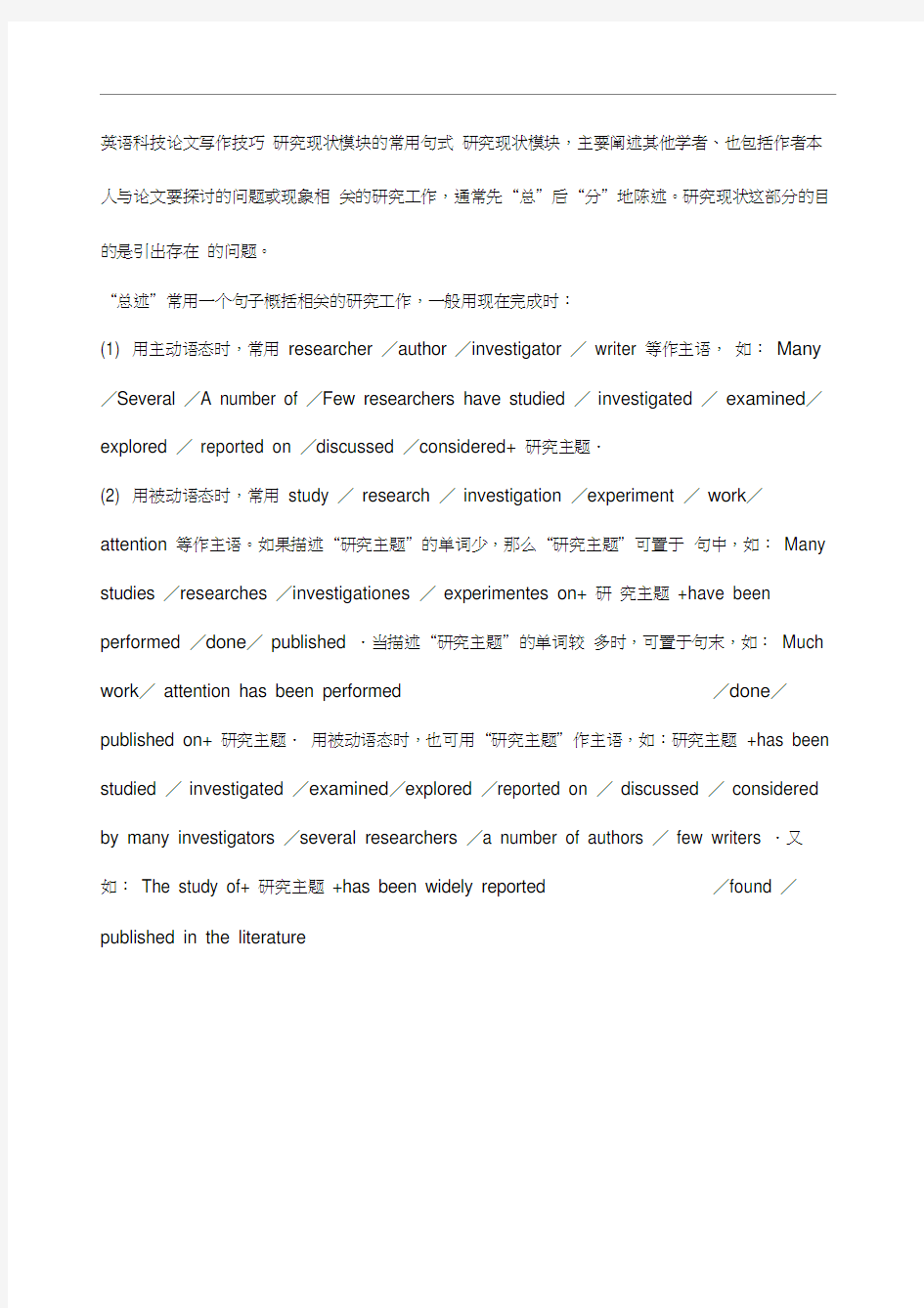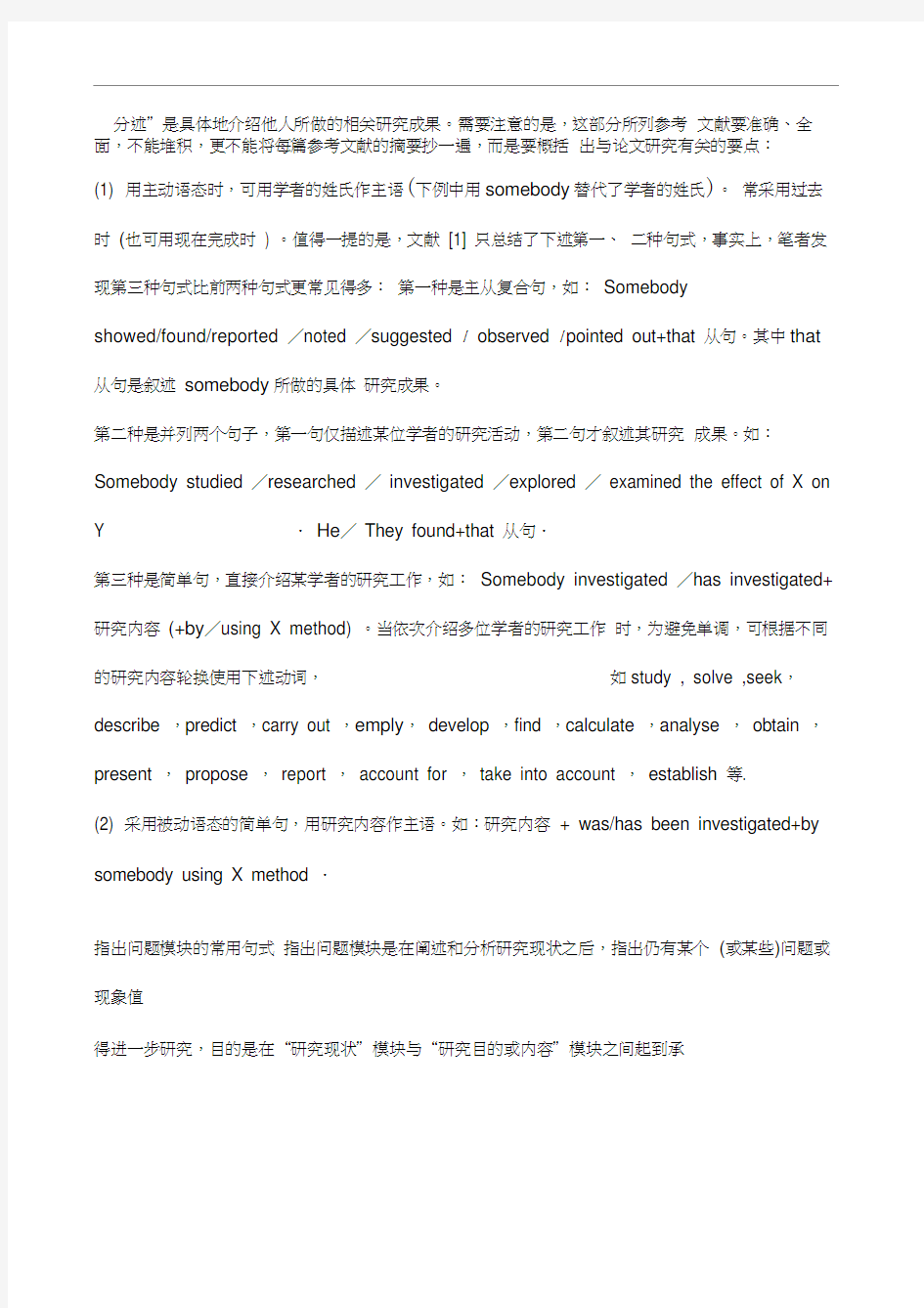

英语科技论文写作技巧研究现状模块的常用句式研究现状模块,主要阐述其他学者、也包括作者本人与论文要探讨的问题或现象相关的研究工作,通常先“总”后“分”地陈述。研究现状这部分的目的是引出存在的问题。
“总述”常用一个句子概括相关的研究工作,一般用现在完成时:
(1) 用主动语态时,常用researcher /author /investigator /writer 等作主语,如:Many /Several /A number of /Few researchers have studied /investigated /examined/explored /reported on /discussed /considered+ 研究主题.
(2) 用被动语态时,常用study /research /investigation /experiment /work/attention 等作主语。如果描述“研究主题”的单词少,那么“研究主题”可置于句中,如:Many studies /researches /investigationes /experimentes on+ 研究主题+have been performed /done/published .当描述“研究主题”的单词较多时,可置于句末,如:Much work/attention has been performed /done/published on+ 研究主题.用被动语态时,也可用“研究主题”作主语,如:研究主题+has been studied /investigated /examined/explored /reported on /discussed /considered by many investigators /several researchers /a number of authors /few writers .又如:The study of+ 研究主题+has been widely reported /found /published in the literature
分述”是具体地介绍他人所做的相关研究成果。需要注意的是,这部分所列参考文献要准确、全面,不能堆积,更不能将每篇参考文献的摘要抄一遍,而是要概括出与论文研究有关的要点:
(1) 用主动语态时,可用学者的姓氏作主语(下例中用somebody替代了学者的姓氏)。常采用过去时(也可用现在完成时) 。值得一提的是,文献[1] 只总结了下述第一、二种句式,事实上,笔者发现第三种句式比前两种句式更常见得多:第一种是主从复合句,如:Somebody
showed/found/reported /noted /suggested / observed /pointed out+that 从句。其中that
从句是叙述somebody所做的具体研究成果。
第二种是并列两个句子,第一句仅描述某位学者的研究活动,第二句才叙述其研究成果。如:Somebody studied /researched /investigated /explored /examined the effect of X on Y .He/They found+that 从句.
第三种是简单句,直接介绍某学者的研究工作,如:Somebody investigated /has investigated+ 研究内容(+by/using X method) 。当依次介绍多位学者的研究工作时,为避免单调,可根据不同的研究内容轮换使用下述动词,如study , solve ,seek,describe ,predict ,carry out ,emply,develop ,find ,calculate ,analyse ,obtain ,present ,propose ,report ,account for ,take into account ,establish 等.
(2) 采用被动语态的简单句,用研究内容作主语。如:研究内容+ was/has been investigated+by somebody using X method .
指出问题模块的常用句式指出问题模块是在阐述和分析研究现状之后,指出仍有某个(或某些)问题或现象值
得进一步研究,目的是在“研究现状”模块与“研究目的或内容”模块之间起到承
上启下的作用,通常1—2个句子即可。可以用It should be mentioned that
导,例如:It should be mentioned that in all references discussed above the foundation has been assumed to be linear in order to simplify the model .但更常见的是用However 引
出:
(1) 阐述“对于论文将要开展的工作,已有文献没有考虑”时,可用现在完成时被
动语态的句式,如口:However,论文中将要展幵的研究工作+have not been considered /have not been taken into account /have been ignored /have been neglected in the mentioned above studies /researches /works/investigations .
(2) 阐述“对于论文将要开展的工作,已有文献研究得较少”时,可以使用形容词
rare ,通常用现在时,如:However,the literature /work/research /attention concerning+ 论文将要展开的研究工作+is rare .但是,更常见的情况是:用few ,little 或no 等修饰词引出。用little 或no 来修饰work ,literature ,research 及attention 等不可数单数名词,用few 或no 来修饰studies ,papers ,researchers 及investigators 等可数的复数名词;后面通常用现在完成时或现在时。
现在完成时的句式:However, few studies have been done on/few studies have been published on /few studies have reported on /few researchers have studied /little research has been devoted to /little attention has been paid
to /little information has been published concerning /no work has been done on/no systematic research has been dedicated to+ 论文将要开展的工作.
现在时的句式:However, little literature is available on /litile is known about
/there is little literature available on+
论文将要开展的工作.
(3) 阐述“对于论文将要开展的工作,已有文献只探讨了相对的工作”时,用:
However,all the researches /studies /inverstigations /works mentioned
above+be limited to /be based on /be concemtrated on+ 相对工作。关于“相对工作”的含义,请参考下述三例理解。(i) ... are limited to the cases that ( the external load is moving on the horizonal beams) .已有文献只研究了水平梁课题,而论文中将要研究的是与之“相对”的倾斜梁(inclined beam)课题。(ii) ... are based on the assumption of ( vehicle /track symmetry in order
to simplify the calculation) .已有文献只研究了车辆/轨道对称课题,而论文
将要研究的是与之“相对”的车辆/轨道不对称(vehicle /track asymmetry ) 课题。(iii) ... are mainly concentrated on ( the forward problem ,
i .e.determination of the dynamic responses due to moving vehicle loads) .已
有文献研究的课题是求解动力响应,而论文将要研究的是与之相对的荷载识别
(inverse problem ,i .e.force identification from the dynamic response of the continuous bridge) 课题。
研究目的或内容模块的常用句式
(1) 用现在时的主动语态句式,例如:This paper describes /presents / develops
/proposes a new model /theory /method for+ 论文将要研究的主题.The objective /purpose /aim of this paper /study is to develop a new model /theory /method for+ 论文将要研究的主题.
(2) 用现在时的被动语态句式,如:In this paper,a general numerical analysis
theory is presented, which is capable of solving... . 又如:An asymmetrical vehicle /track dynamic model,which is a finite element time —domain model,is presented in this paper .
(3)如果论文是对已有研究工作的扩展,可用下列包含extension 或extend 的句
式。如:This paper call be regarded as all extension of the paper by somebody, as the latter laid the theortical foundation for the present study .又如:this paper extends the theoretical framework laid down by somebody for the analysis of+ 论文将要研究的主题.
英文摘要撰写的一般技巧由于大多数检索系统只收录论文的摘要部分或其数据库中只有摘要部分免费提
供,并且有些读者只阅读摘要而不读全文或常根据摘要来判断是否需要阅读全文,
因此摘要的清楚表达十分重要。为确保摘要的“独立性” (stand on its own)或“自
明性” (self -contained),撰写中应遵循以下规则:
(1)为确保简洁而充分地表述论文的IMRD(Introduction, Methods, Results and Discussion)结构的写作模式,可适当强调研究中的创新、重要之处(但不要使用评价性语
言);尽量包括论文中的主要论点和重要细节(重要的论证或数据)。
(2)使用简短的句子,表达要准确、简洁、清楚;注意表述的逻辑性,尽量使
用指示性的词语来表达论文的不同部分(层次),如使用“We found that…”表
示结果;使用“ We suggest that…”表示讨论结果的含义等。
(3)应尽量避免引用文献、图表,用词应为潜在的读者所熟悉。若无法回避使用引文,应在引文出现的位置将引文的书目信息标注在方括号内;如确有需要(如避免多次重复较长的术语)使用非同行熟知的缩写,应在缩写符号第一次出现时给出其全称。
(4)为方便检索系统转录,应尽量避免使用化学结构式、数学表达式、角标和希腊文等特殊符号。
(5)查询拟投稿期刊的读者须知,以了解其对摘要的字数和形式的要求。如果是结构式摘要,应了解其分为几段,使用何种标识、时态,是否使用缩写或简写,等等。
摘要写作的时态摘要写作时所采用的时态应因情况而定,力求表达自然、妥当。写作中可大致
遵循以下原则:
(1)介绍背景资料时,如果句子的内容为不受时间影响的普遍事实,应使用现在式;如果句子的内容是对某种研究趋势的概述,则使用现在完成式。例如:
The authors review risk and protective factors for drug abuse, assess a number of approaches for drug abuse prevention potential with high-risk groups, and makerecommendations for research and practice. [Psychological Bulletin, 1992, 112 (1): 64-105]
Previous research has con firmed four dime nsions of temperame nt: …
[ Archives of General Psychiatry, 1993, 50 (12): 975-990]
(2)在叙述研究目的或主要研究活动时,如果采用“论文导向”,多使用现在式(如:This paper presents …); 如果采用“研究导向”,则使用过去式(如:This study investigated …)。This article summarizes research on self-initiated and professionally
facilitated change of addictive behaviors using the key transtheoretical constructs of stages and processes of change. [American Psychologist, 1992, 47 (9): 1102-1114] Weinvestigated whether captopril could reduce morbidity and mortality
in patients with left ventricular dysfunction after a myocardial infarction.
[ New England Journal of Medicine, 1992, 327 (10): 669-677]
(3)概述实验程序、方法和主要结果时,通常用现在式。
Wedescribe a new molecular approach to analyzing the genetic diversity of complex microbial populations. [Applied and Environmental Microbiology, 1993, 59 (3): 695-700] Our results indicate that p21 may be a universal inhibitor of cyclin
kinases. [Nature, 1993, 366 (6456): 701-704]
(4)叙述结论或建议时,可使用现在式、臆测动词或may, should, could 等
助动词。
We suggest that climate instability in the early part of the last
interglacial mayhave delayed the melting of the Saalean ice sheets in America and Eurasia, perhaps accounting for this discrepancy. [Nature, 1993, 364 (6434): 218-220] 摘要写作的人称和语态
有相当数量的作者和审稿人认为,科技论文的撰写应使用第三人称、过去时和被动语态。但调查表明,科技论文中被动语态的使用在19201970 年曾经比较流行,但由于主动语态的表达更为准确,且更易阅读,因而目前大多数期刊都提倡使用主动态。国际知名科技期刊“ Nature ”,
“Cell ”等尤其如此,其中第一人称和主动语态的使用十分普遍。
在论文撰写时应认真调查一下拟投稿期刊有关人称和语态的使用习惯,为简洁、清
楚地表达研究成果,在论文摘要的撰写中不应刻意回避第一人称和主动语态。
随着学校对科技论文质量与档次的要求提高,近几年来越来越多的读者欲向SCI
EI 投稿,由于对投稿要求与方式不太清楚,使本来质量较高的论文没能达到预期
的效果。为了让读者能顺利进入SCI 、EI 刊源, 我们综合专家、有关权威机构的评价标准及各项要求给您如下投稿要求与技巧,也许会对你投稿有所帮助。
一稿件内容和学术水平
(1)SCI 对稿件内容和学术水平的要求
1) 主要收录数学、物理、化学等学术理论价值高并具有创新的论文;
2) 国家自然科学基金资助项目、科技攻关项目、八六三高技术项目等;
3) 论文已达到国际先进水平。
(2)EI 对稿件内容和学术水平的要求
1) 具有较高的学术水平的工程论文, 如:
-- 工程管理;
-- 矿业与冶金、材料工程;
-- 机械与电子工程、制造技术;
-- 电子与电气工程、计算机科学;
-- 化学与化工、生物技术、轻工纺织与食品工业;
-- 土木建筑工程、海洋与水利工程、船舶工程;
EI 一般不收录数理化、生物学、医药、农林等学术理论论文。
2) 国家自然科学基金资助项目、科技攻关项目、八六三高技术项目等。
3) 论文达到国际先进水平, 成果有创新。
二投稿技巧
(1)专家指出投稿首先文章题目要准确,切记题不对文。中文文章标题常用
的xxx研究(Study on…or Stydies on …)要尽量少用。实验方法要清晰,
达到让同行能明白、能重复的水平。仪器设备、化学试剂、实验动物等,尽量用国际上承认和通用的,少用别人找不到的仪器和试剂
2)实验结果部分仅写实验结果,讨论和评论的话一句也不要说,适当多用
图、表或照片描述实验结果,图、表或照片要清晰、图标要简单明了。
(3)讨论部分最重要,中文文章中讨论的内容太少,英文文章要求将实验的意义、实验中出现的问题、实验结果的分析、某些结果引申的意义和问题、甚至下一步的设想都包括在讨论的范畴内。
(4)另外,论文的书写格式要符合所投寄杂志的要求。在杂志的最前面或最后面都有对书写格式的要求,最简单的方法是找一篇将要投寄的杂志上的文章,按照该文章的格式书写。